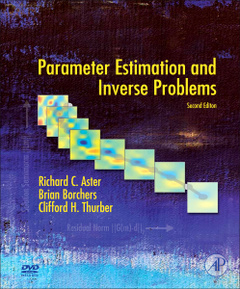Description
Parameter Estimation and Inverse Problems (2nd Ed.)
Authors: Aster Richard C., Borchers Brian, Thurber Clifford H.
Language: English
Subjects for Parameter Estimation and Inverse Problems:
Keywords
ART; Basis Functions; Bayes Theorem; Bayesian Parameter Estimation; Bound Constraints; Compressed Sensing; Compressive Sensing; Confidence Ellipsoid; Conjugate Gradient Least Squares; Conjugate Gradient Method; Discrepancy Principle; Discrete Fourier Transform; Discrete Inverse Problem; Filter Factor; Fourier Transform; Fredholm Integral Equation; Gauss-Newton Method; Generalized Cross-Validation; Generalized Singular Value Decomposition; Gram Matrix; Ill-Conditioning; Inverse Problem; Iterative Resolution Analysis; Kaczmarz's Algorithm; L-curve; Levenberg-Marquardt Method; Linear Least Squares Problem; Linear Regression; Markov Chain Monte Carlo; Maximum Likelihood Estimation; Method of Backus and Gilbert; Monte Carlo Error Propagation; Nonlinear Inverse Problem; Nonlinear Regression; Occam's Inversion; Picard Condition; Posterior Distribution; Prior Distribution; Rank Deficiency; Resolution Analysis; Resolution Matrix; Robust Regression; Row Action Method; Seismic Tomography; Simple Collocation; Singular Value Decomposition; SIRT; Sparsity Regularization; Spectral Deconvolution; Tikhonov Regularization; Total Variation; Water Level Regularization
Publication date: 08-2016
Support: Print on demand
Replaced by new edition: Access to the new edition.
Publication date: 02-2012
376 p. · 19x23.3 cm · Hardback
Replaced by new edition: Access to the new edition.
Description
/li>Contents
/li>Readership
/li>Biography
/li>Comment
/li>
Parameter Estimation and Inverse Problems, Second Edition provides geoscience students and professionals with answers to common questions like how one can derive a physical model from a finite set of observations containing errors, and how one may determine the quality of such a model. This book takes on these fundamental and challenging problems, introducing students and professionals to the broad range of approaches that lie in the realm of inverse theory. The authors present both the underlying theory and practical algorithms for solving inverse problems. The authors? treatment is appropriate for geoscience graduate students and advanced undergraduates with a basic working knowledge of calculus, linear algebra, and statistics.
Parameter Estimation and Inverse Problems, Second Edition introduces readers to both Classical and Bayesian approaches to linear and nonlinear problems with particular attention paid to computational, mathematical, and statistical issues related to their application to geophysical problems. The textbook includes Appendices covering essential linear algebra, statistics, and notation in the context of the subject.
This title will be of interest primarily to geoscientists in academe and in the field. This market includes geoscience scientists, researchers, instructors and students studying key areas like geology, geophysics, geochemistry, geomorphology, atmospheric physics, astronomy and hydrology.
Dr. Borchers’ primary research and teaching interests are in optimization and inverse problems. He teaches a number of undergraduate and graduate courses at NMT in linear programming, nonlinear programming, time series analysis, and geophysical inverse problems. Dr. Borchers’ research has focused on interior point methods for linear and semidefinite programming and applications of these techniques to combinatorial optimization problems. He has also done work on inverse problems in geophysics and hydrology using linear and nonlinear least squares and Tikhonov regularization.
Professor Thurber is an international leader in research on three-dimensional seismic imaging ("seismic tomography") using earthquakes. His primary research interests are in the application of seismic tomography to fault zones, volcanoes, and subduction zones, with a long-term focus on the San Andreas fault in central California and volcanoes in Hawaii and Alaska. Other areas of expertise include earthquake location (the topic of a book he edited) and geophysical inverse theory.
- Includes appendices for review of needed concepts in linear, statistics, and vector calculus.
- Accessible to students and professionals without a highly specialized mathematical background.




